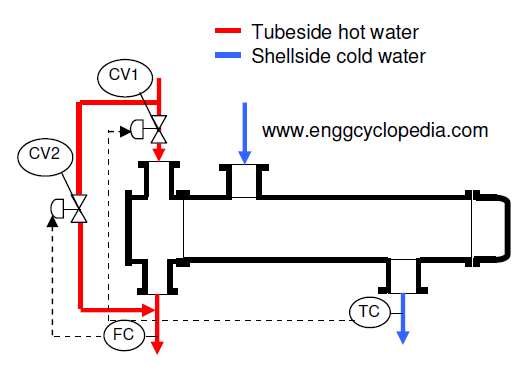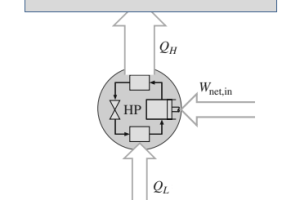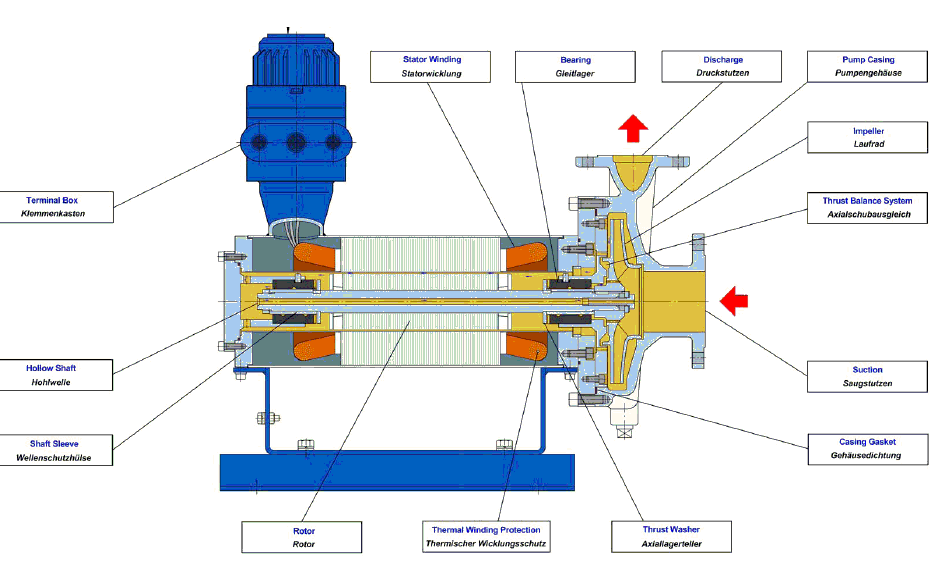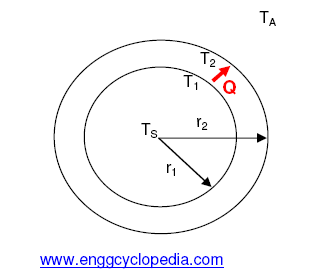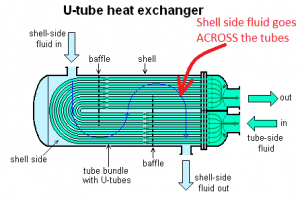Different types of heat transfer equipment are widely used in the process industry to heat up or cool down process fluids. Out of all the different types of heat exchangers, shell and tube heat exchangers are quite popular and widely used for a variety of applications. This post contains a comprehensive study of the shell and tube heat exchanger parts.
Table of Content:
Diagram
Shell
Shell Cover
Tubes
Tube Sheet
Bonnet
Channel
Pass Partition Plate
Nozzles
Baffles
Tie Rods
Baffle Spacers
Flanges and Gaskets
Headers
Expansion Joints
Diagram
The following diagram is the structure of a TEMA style shell and tube heat exchanger. The diagram itself is based on the TEMA standards. This diagram illustrates all the important parts in the design of a shell & tube heat exchanger, as per the TEMA standards. For the exact correct nomenclature for each of those parts, click here.
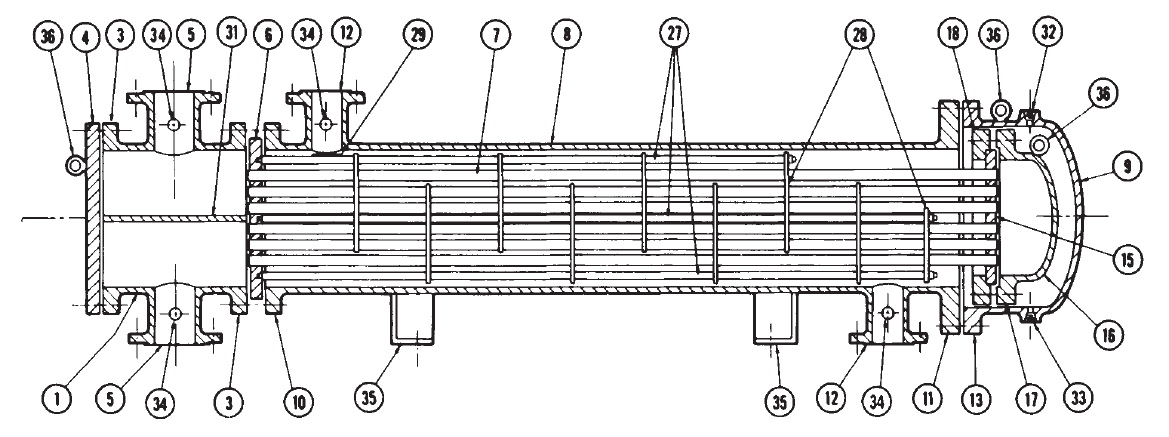
Shell
Shell is the outer covering of the heat exchanger. It is a cylindrical casing that acts as an enclosure for a bundle of tubes through which shell-side fluid passes.
Design: For a bigger size shell, the shell is constructed by rolling a metal plate and welding it in an axial direction. When the shell diameter is less than 60 cm a pipe of suitable thickness can be used as a shell.
Material of Construction (MOC): Carbon Steel is the most widely used material for the construction of the shell. But it will be dependent on operating conditions and the fluid to be used.
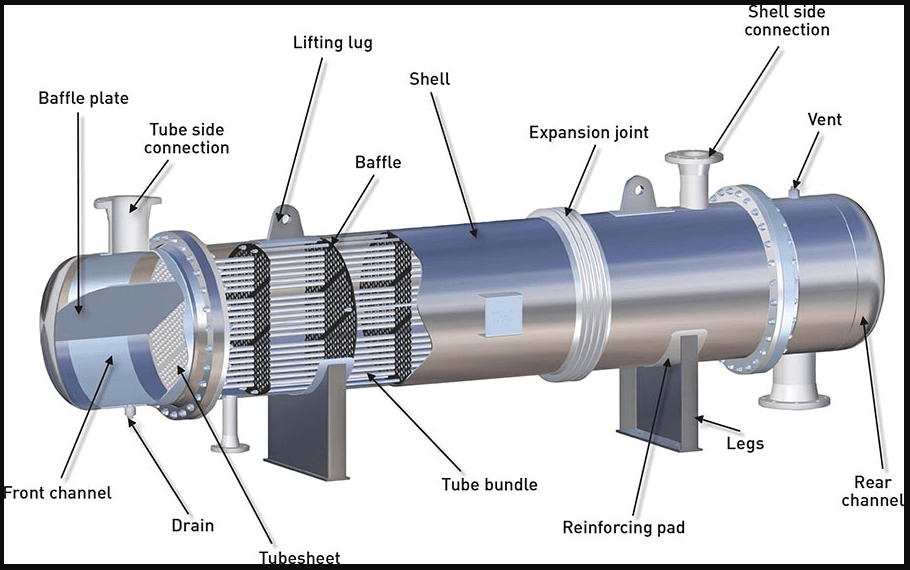
Shell Cover
The shell cover is a removable part of a shell and tube heat exchanger that provides access to the inside of the shell for maintenance or inspection purposes. It is attached to the shell and can be fastened by bolts or other means, and can be opened and closed to access the interior of the shell.
One of the main functions of the shell cover is to hold the tubes in place and support the weight of the tube bundle.
MOC: The cover is typically made of the same material as the tubes and is designed to withstand the high pressure and temperature of the fluids flowing through the tubes.
Tubes
Tubes are the most important part of a heat exchanger because tube walls separate the two fluids and act as a surface for heat transfer between the two fluids. The fluid to be heated or cooled flows through the tubes which are called tube-side fluid. Finned tubes can also be used to increase the surface area of heat transfer.
MOC: Tubes are mostly made of Carbon Steel. Apart from that tubes can be constructed from Stainless Steel, Cupronickel, Copper, Brass, and Aluminium. The choice of material for the tube depends on operating conditions and the fluid to be used.
Tube Thickness: The outer diameter of tubes varies between 6 mm to 40 mm. But Tubes with 19 mm and 25 mm outer diameters are very common. Narrower tubes are used for small heat exchangers and clean fluids. The thickness of tubes is expressed in Birmingham Wire Gauge (BWG) and it depends on operating conditions and fluids to be handled.
Tube Arrangements: Tubes are arranged in either square pitch or triangular pitch configuration. However, a Triangular pitch configuration is preferable as it provides more heat transfer area, a higher heat transfer coefficient, and high heat exchanger efficiency. But exchanger with a triangular pitch configuration is difficult to clean and has a higher pressure drop compared to the square pitch arrangement.
Tube Sheet
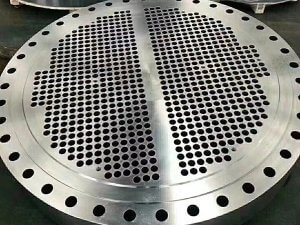
These are the circular thick metal sheets with holes drilled through them and used to hold the tubes at both ends. When the tube sheet at both ends is fixed, it is called a Fixed head shell & tube heat exchanger. When the tube sheet at one end is fixed and floating at the other end then it is called a Floating head shell & tube heat exchanger.
The leak-free tube to tube sheet joint is made by the conventional rolling process. The tube sheet will have a layout depending on the arrangement of the tubes.
Bonnet
The bonnet is a cover that seals the end of the heat exchanger and provides access to the tubes and internals. It has an integral cover. The bonnet provides access to the internal components of the heat exchanger, making it easier to inspect, clean, or perform maintenance on the tubes and other parts. The bonnet is designed to withstand the pressure of the fluid streams, ensuring that it does not leak or become damaged.
MOC: It is typically made of metal, such as stainless steel or carbon steel, and is attached to the end of the shell with bolts or clamps.
Channel
A channel in a shell and tube heat exchanger is a metal component located inside the shell that separates the fluid streams. The channel separates the fluid streams, directing them into separate tubes or pathways. The channel helps to stabilize the fluid streams, preventing them from becoming unstable or surging.
MOC: It is typically made of metal, such as stainless steel or carbon steel, and serves to divide the fluid into separate streams and direct it through the tubes.
Pass Partition Plate
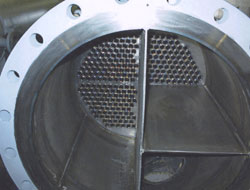
A horizontal divider is enclosed within the fixed or floating head cover of a shell and tube heat exchanger. Pass partition plates are used to increase the number of passes in an exchanger. A number of passes indicate the number of times the shell or tube side fluid traverses the length of the heat exchanger. To increase the tube side pass we will use the tube side plate and to increase the shell side pass we will use the shell side plate.
By using the pass partition plate we are increasing the number of passes. It results in a reduction of flow area for the fluid, an increase in turbulence, and an increase in heat transfer coefficient. But it increases in pressure drop also.
When the amount of fluid flow is less the on shell side or tube side, we can use the pass partition plate to increase number flow rate on that side. Tube side plates are placed in the nozzle or bonnet and shell side plates are placed throughout the shell.
Nozzles
They are present on both shell and tube sides, to facilitate the flow of the shell and tube side fluids between the heat exchanger and inlet/outlet piping. Nozzles are small pipe section of suitable size. These are welded to the shell or bonnet on one side. And on the other side, it is fitted with flanges to connect with pipelines.
Just below the shell side nozzle impingement plates are placed. It stops direct hitting of shell side fluid to tubes and avoids damage to the tubes.
Baffles
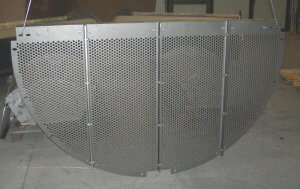
The baffle is a metal plate in the form of a segment of a circle with necessary holes to accommodate tubes. These are used to provide structural support for inner tubes and also reduce the vibration of tubes. Baffles create turbulence on the shell side by directing the flow of the shell side fluid in the desired direction which increases the convective heat transfer coefficient of the shell side fluid. Therefore, the rate of heat transfer increases which increases the effectiveness of the heat exchanger.
The small grooves are present in baffles which are used to drain out all the liquid present on the shell side during maintenance activities.
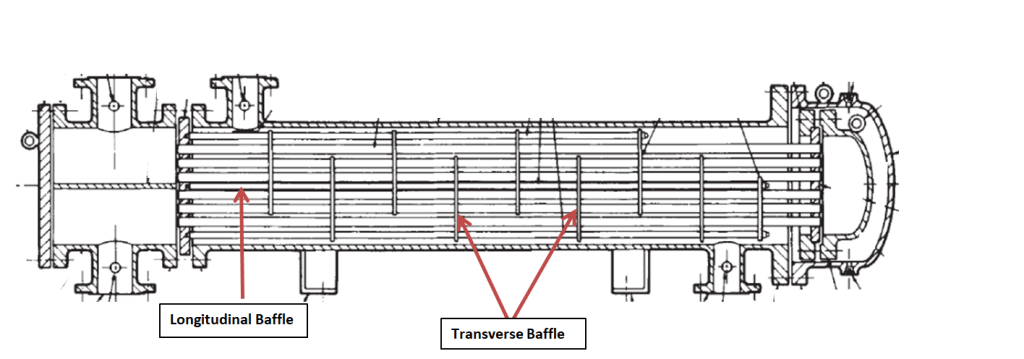
Click here to check detailed post on baffles in heat exchangers.
Baffle Spacing: The center-to-center distance between adjacent baffles is called Baffle Spacing. Proper baffle spacing is needed to achieve minimum pressure drop. So baffle spacing should not be greater than the inside diameter of the shell and should not be less than one-fifth of the inside diameter of the shell. The optimum baffle spacing is 0.3-0.5 times the shell diameter.
It is very important to maintain optimal shell side baffle spacing to ensure best operating efficiency.
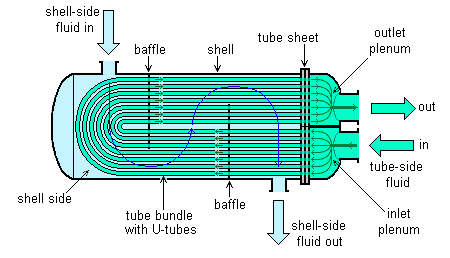
Tie Rods
The tie rod is a component used in shell and tube heat exchangers to provide structural support and maintain the pressure vessel's shape. It is a long, horizontal, threaded rod that is inserted through the shell, connecting the two tube sheets to maintain the shape and stability of the exchanger under high pressure. The tie rod is tightened to apply tension and maintain the shell's cylindrical shape, preventing deformation or buckling under pressure. A tie rod is also used to hold the baffles in an upright condition.
Baffle Spacers
Baffle spacers are components in a shell and tube heat exchanger used to provide a fixed distance between adjacent baffles. These are hollow tubes slid over tie rods. It stays between the baffles to keep the distance between baffles intact. These spacers allow us to maintain sufficient distance between baffles. The spacers are typically made of materials that are resistant to the temperatures and pressures present in the heat exchanger. These are designed to withstand the forces of the fluid flow and maintain their position over time.
Flanges and Gaskets
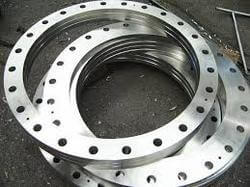
Flanges are ring-shaped components that are attached to the inlet and outlet headers of the heat exchanger. They provide a secure connection point for fluid inlets and outlets and can be tightened using bolts. The tube sheet also acts as a flange in the shell and tube heat exchanger.
Gaskets are seals placed between the flange and the header to prevent fluid from leaking. They are made of materials that are compatible with the fluids and temperatures present in the heat exchanger and are designed to withstand the pressure of the fluid. Compressed asbestos fiber, Jacketed asbestos, and PTFE are examples of gaskets used.
Together, flanges and gaskets play a critical role in ensuring the safe and reliable operation of the shell and tube heat exchanger by preventing fluid leaks and ensuring that the connections are secure.
Headers
Headers are components in a shell and tube heat exchanger that serve as the inlet and outlet connections for the fluid. The inlet header is a component located at the entrance of the heat exchanger that directs the incoming fluid into the tubes. The outlet header is a component located at the exit of the heat exchanger that directs the outgoing fluid from the tubes.
Expansion Joints
Expansion joints are components in a shell and tube heat exchanger that allow for the thermal expansion of the shell and tubes. They are designed to accommodate the changes in dimensions that occur when the heat exchanger is exposed to high temperatures.
Expansion joints consist of flexible bellows or other materials that can expand and contract with temperature changes, while still maintaining a tight seal. They are typically located between the shell and the tube sheets, or between the end covers and the shell. The use of expansion joints helps to prevent damage to the heat exchanger caused by thermal expansion and ensures that the heat exchanger operates reliably and efficiently.
